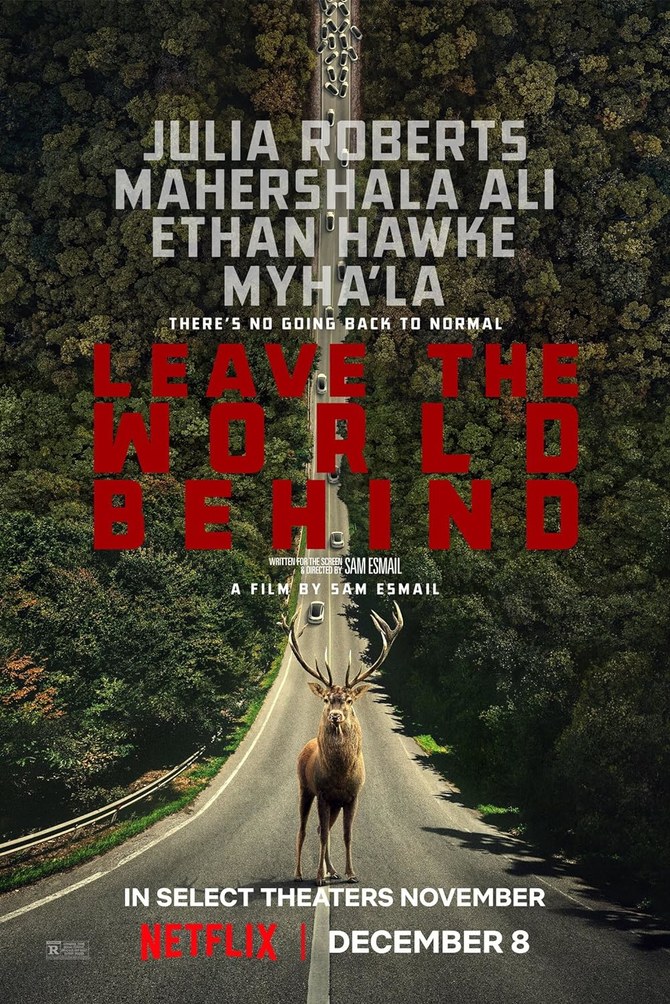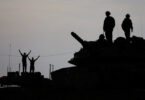Dalia Al-Aqidi
In my career as a writer, I have rarely ventured into the realm of film criticism. However, as an ardent admirer of disaster movies and apocalyptic thrillers, I find myself compelled to break my customary silence.
Often, films within this genre struggle to encompass essential elements such as exceptional acting, masterful direction, impeccable cinematography, and immersive visual effects, not to mention the necessary budget to bring their ambitious concepts to life. Yet, amid the crowded cinematic landscape, “Leave the World Behind” emerges as a striking anomaly. In telling the story of a world confronted with an unparalleled crisis, this cinematic masterpiece delivers a riveting and thought-provoking exploration of human nature and society.
Adapted from Rumaan Alam’s novel of the same name, “Leave the World Behind” invites viewers on a captivating journey into the depths of human experience. Set against the serene backdrop of a remote vacation rental home on Long Island, the narrative unfolds as two families, the Clays and the Washingtons, seek refuge from the relentless chaos of their everyday lives. Little do they suspect that their tranquil getaway will swiftly metamorphose into a profound meditation on trust, fear and the gradual erosion of societal norms.
The plot takes an unforeseen turn when a mysterious and unexplained blackout descends upon the secluded haven, severing the families’ ties to the outside world. Deprived of access to information and communication, the fragile cocoon of comfort and security that had surrounded them begins to unravel. It is within these walls, amid the enveloping shroud of uncertainty, that the authentic essence of the characters is revealed.
Perhaps one of the most resonant themes explored in “Leave the World Behind” is the poignant examination of trust among people confronted with the unknown. As the families grapple with the enigma of the blackout and the potential perils lurking beyond, they are faced with a momentous choice — whether to place their trust in one another or succumb to the all-encompassing grip of paranoia.
This serves as a microcosm for the broader societal challenges relating to trust and cooperation, mirroring the struggles that pervade our increasingly fragmented world.
Moreover, the film boldly explores the intricate tapestry of race, class, and generational disparities. The characters are compelled to confront their own deeply ingrained biases and preconceptions as they navigate the crisis together. These divisions, again reflective of broader societal issues, underscore the elusive nature of true understanding among diverse groups.
“Leave the World Behind” presents us with characters left to their own devices in the absence of a functioning society, and in doing so it lays bare the primal instincts simmering beneath the facade of seemingly structured lives. The dissolution of societal norms and the relentless struggle for survival expose the raw, unvarnished facets of human nature — the instinct to protect oneself, the quest for dominance, and the pervasive fear of the unknown.
As viewers become engrossed in the film’s compelling narrative, the artistry of the actors is entrancing, as is the precision of the camera movements and the unrelenting atmosphere of suspense. Yet, beneath the surface, a series of essential and potentially hazardous messages begins to make their presence felt. These messages are skillfully woven into the fabric of the storytelling, leaving little space for the audience to pause and critically analyze them. Instead, they are presented in a manner that encourages immediate acceptance as undeniable realities.
This subtle approach to message delivery profoundly affects the viewer’s experience. The artful blending of these messages into the narrative creates an atmosphere in which they are seamlessly integrated into the plot, characters, and dialogue. As a result, the audience is less likely to perceive them as distinct elements to be scrutinized but rather as integral components of the story’s overarching themes and messages.
As the story unfolds, a series of events point toward a coalition of rogue nations uniting with the sinister intent of orchestrating a cyberterrorist assault on the US, resulting in widespread disruption and chaos. These evil actions are vividly portrayed through scenes of bombings in New York City.
The overarching objective of this clandestine electronic group is to destabilize society to the extent that it ignites a civil war for survival. This ominous message is conveyed to the public through one of the characters. People are made aware of the impending threat when drones drop pamphlets, printed in various languages, bearing the menacing message, “Death to America.”
After watching the film, my curiosity led me to delve deeper into its production and I discovered that Barack and Michelle Obama, the former US president and his first lady, served as executive producers through their production company, Higher Ground. Notably, the 44th president had significant involvement in shaping the intricacies of the film’s plot. As revealed by Sam Esmail, who directed the film and adapted the screenplay, the former president provided extensive script notes, underscoring his active contribution to the development of the movie.
“He had a lot of notes about the characters and the empathy we would have for them,” Esmail told Vanity Fair. “I have to say he is a big movie lover and he wasn’t just giving notes about things that were from his background. He was giving notes as a fan of the book and he wanted to see a really good film.
Obama thought the completed script was pretty close to how such a crisis would actually play out in the real world, Esmail added.
A three-pronged attack strategy characterizes the unfolding sequence of events depicted in the film. The initial phase is marked by a deliberate attempt to isolate people. This is followed by a meticulously orchestrated period of synchronized chaos. The narrative culminates in the third stage, which shows the start of a civil war.
“Whoever started this wants us to finish it,” one of the characters astutely observes, emphasizing the relentless pursuit of a hidden agenda that propels the story forward.
While there might be various reasons why the Obamas’ production company chose this particular story for one of its early film projects, the film undeniably has evoked a profound sense of fear and apprehension among many. It has prompted reflection on the unsettling possibility that a future exists in which adversaries could try to undermine the US not through the traditional means of military force, but through cyberterror and societal destabilization.
This has sparked a sense of pessimism and questions about the resilience of American society in the face of such challenges. In the face of these questions, and by choosing to produce this film, the Obamas have exposed a nation tinged with a palpable sense of concern and apprehension.







